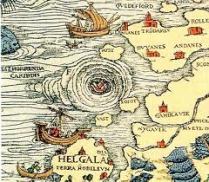I

WORRISOME?
The Greenland ice sheet has apparently melted this month at a rate considerably in excess of any other thaw in recorded history. This follows the calving of an iceberg from the Petermann glacier the size of Manhattan. Goddard Space Flight Center glaciologist Lora Koenig said, “If we continue to observe melting events like this in upcoming years, it will be worrisome.”
Last year, a University of Washington study led by Twila Moon used satellite data to track the progress of two hundred Greenland glaciers between 2000 and 2010: “Previous studies only had a couple of observations from big glaciers. We found we are certainly not on the worst-case scenario, but the glaciers are speeding up and we see no sign of that stopping. We found, contrary to conventional wisdom, that glaciers have rapid and large changes in speed.” Regarding the resulting inevitable rise in sea levels, Ms. Moon noted: “If you raise the floor of a basketball court by just a few inches, you will see many more slam dunks.”
Leaving the curiously unsupportable logic of grounded bodies dunking a floating net aside, if the rate of melt increases any further, even to the point of Moon’s “worst-case scenario”, will we then get to spike the football?
II

As one sheet melts into the sea, another takes shape as an immense gyre created from tiny pieces of pelagic plastic and other industrial debris floating beneath the surface; water within the gyre contains at least six times more plastic molecules than phytoplankton, the organisms that occupy the bottom (and most essential) rung of the marine food chain. A 2008 study found a ratio of forty six to one, suggesting that the rate of concentration is accelerating through time. Estimates of size vary widely, reflecting the difficulty of defining boundaries; where does it begin and where does it end?
In 2009, photographer Chris Jordan travelled to Midway Island to document the death of baby albatrosses. Mothers scoop the plastic from the gyre and feed it to their babies. The bodies of the baby albatrosses decompose, yet the previously ingested plastic remains intact. These dramatic photographs caused a momentary global crise de conscience, and then they too disappeared into the opaque plastic soup.

DECOMPOSED INDIGESTION
III
We recently attended a poetry reading at a nearby gallery, and in the thematic environs of Birds, Bats & Riddles. The riddler-poet was Jon Swan, whose poems celebrate resilience and grieve degradation, sometimes within the very same line. Among the many excellent poems voiced by Swan on this occasion:


ANGELS OF GRACE, FORGIVE US











